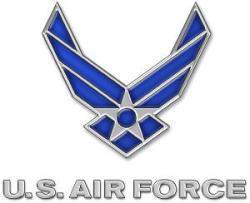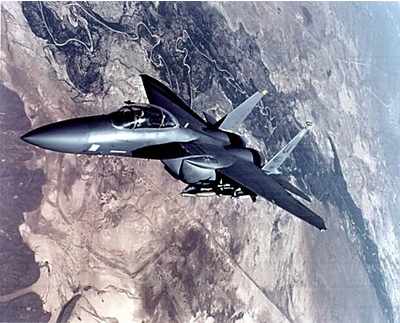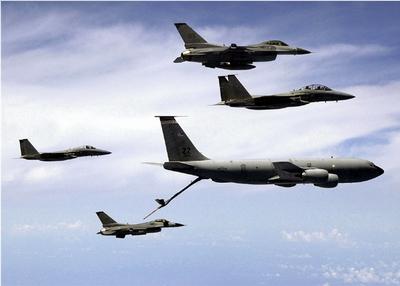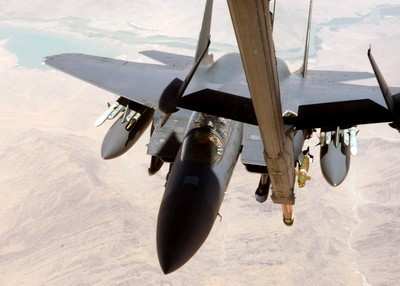Includes "Hands-On" Time In F-15 Sim
 Civilian business and community leaders got firsthand and
sometimes hands-on exposure Tuesday to US Air Forces in Europe's
multiple missions of supporting warfighters, building partnerships
and strengthening its historic NATO ties.
Civilian business and community leaders got firsthand and
sometimes hands-on exposure Tuesday to US Air Forces in Europe's
multiple missions of supporting warfighters, building partnerships
and strengthening its historic NATO ties.
US Air Forces, Europe, or USAFE, is as critical to US national
defense today as when it was established as the 8th Air Force in
1942 and flew heavy bombardment missions over the European
continent during World War II, Air Force Maj. Gen. James Hunt, its
director of air and space operations, told 47 participants in the
Joint Civilian Orientation Conference.
"For 66 years, US Air Forces, Europe, has provided responsive
forward presence, humanitarian and peacekeeping support and
decisive airpower to the United States and its allies," Hunt told
the group.
US European Command's air component is far different from the
organization that stood up during World War II, then went on to
play a key role in the Berlin Airlift and as an important deterrent
to a large-scale conflict across the Fulda Gap. "This is not the
organization of the Cold War," Hunt said.
Today a streamlined USAFE organization -- five bases and nine
forward operating bases, 250 aircraft and about 25,000 airmen --
directs air operations in a theater spanning 20 million square
miles, 91 countries and covering a quarter of the world's
population, he told the group.
While that's down from 25 bases, 750 aircraft and more than
65,000 airmen in 1990, he said it's no indication of a lesser role.
"The mission for USAFE is bigger than ever," Hunt said, citing its
transformation into an expeditionary force and the breadth of the
missions it now conducts.
Hunt called support to warfighters -- airlift, refueling,
close-air support and casualty evacuation -- a top USAFE priority.
"Our job is to make sure the force on the ground gets what they
need," he said.
But USAFE's mission goes beyond the current fight, he said. Its
focus extends to security cooperation throughout the region –
not just with traditional NATO allies, but also with new NATO
members and partners. During fiscal year 2007, USAFE had more than
900 engagements in Europe and Asia, all aimed at improving mutual
cooperation and helping nations that seek to build capability in
their air forces.

Capt. Curt Dougherty, a Strike Eagle pilot, described a recent
cross-training exercise in Eastern Europe, calling it as valuable
for him and his squadron as for the Bulgarian and Romanian pilots
they were training. "It's a great opportunity because you get to
train against aircraft you wouldn't otherwise have the opportunity
to train with," he said. "You really do take a lot of concepts out
of the experience."
The JCOC participants kicked off their visit Tuesday at nearby
at RAF Mildenhall, where they got a demonstration of some of the
capabilities USAFE brings to the fight. Five 321st Special Tactics
Squadron combat controllers conducted a high-altitude, low-opening
jump, dropping from an MC-130H aircraft at 10,000 feet and waiting
until 3,500 to open their parachutes to land on an "enemy airfield"
without detection.
F-15C Eagles and F-15E Strike Eagles, F-16 Fighting Falcons and
A-10 Thunderbolt II aircraft roared overhead followed with
explosions on the ground simulating the precise firepower they
would deliver to take out enemy elements. Once the targets were
eliminated, an MC-130 aircraft delivered more paratroopers to
secure the airfield.
"What you saw out there is an example of what airpower is today,
and it's not Goose or Maverick," Col. Lawrence Reed, vice commander
of the 48th Fighter Wing, told the visitors, referring to the lead
characters in the movie, Top Gun. "It's a very precise and very
disciplined operation to put things on bad guys and protect the
good guys."
At RAF Lakenheath, the JCOC participants got more hands-on
exposure to USAFE's weapons systems and equipment and the
opportunity to meet the airmen who operate them.
The group watched weapons teams go through the step-by-step
process required to load munitions aboard F-15s for
close-air-support missions. "When you are on alert and you get a
call, the jet has to be loaded as fast and as safely as possible,"
Senior Airman David Ross told the visitors. "You need to be fast
because of the tempo downrange."

The civilians climbed into the cockpits of F-15 aircraft,
quizzing the pilots about the controls and their combat experience.
Capt. Curt Dougherty, a Strike Eagle pilot who's deployed to both
Iraq and Afghanistan and is preparing to return for an upcoming
deployment, described what his squadron and other Air Force assets
bring to the fight.
"We are the on-call close air support, supporting the commanders
in the theater," Dougherty said. "What we do supports the guys on
the ground and helps to keep them safe."
The group moved from station to station, learning about the
workings of the F-15 engine and the KC-135 Stratotanker, talking
with special operators about their equipment and tactics watching a
working-dog demonstration.
At one station, Airman Jason Jeffers demonstrated how he and his
fellow "battlefield airmen" use robots to disable and destroy
improvised explosive devices in Iraq and Afghanistan.
"A lot of people don't know that we're out there on the ground,"
said Jeffers, who is preparing for an upcoming deployment to the
combat zone. "What we are doing allows forces to get through roads
to complete their mission. We are going down there and we are
saving lives."
A highlight for many was taking the controls of an F-15
simulator to experience the kind of training pilots go through to
prepare for real-life missions. "We had them flying two F-15s
side-by-side, running an intercept and trying to conduct an
air-to-air engagement," explained site manger Spike Hafermann.
"They're having a lot of fun," he said. "But they are also getting
to see the realism of the training device and the type of
technology we use to prepare our combat flyers before they go
downrange."
As they compared stories about how well they'd done, or how
quickly they'd "crashed," the JCOC participants shared impressions
of what they'd witnessed during their USAFE visit.

"It was just fabulous," said Darrel Flanel, managing director
for Merill Lynch Global Markets in New York. "I come away from this
really impressed with extensive knowledge. The depth of intellect
and the enthusiasm I saw, it's pretty amazing."
Reed said he welcomed the opportunity to show the civilian
leaders what he called "the heart of who we are, our enlisted
force," and the responsibility they carry in supporting the mission
and US national defense. "We're making demands on them every day,
and every day, they are exceeding everything we asked of them," he
said.
(Aero-News thanks Donna Miles, American Forces Press
Service)
 ANN's Daily Aero-Linx (05.06.25)
ANN's Daily Aero-Linx (05.06.25) ANN's Daily Aero-Term (05.06.25): Ultrahigh Frequency (UHF)
ANN's Daily Aero-Term (05.06.25): Ultrahigh Frequency (UHF) ANN FAQ: Q&A 101
ANN FAQ: Q&A 101 Classic Aero-TV: Virtual Reality Painting--PPG Leverages Technology for Training
Classic Aero-TV: Virtual Reality Painting--PPG Leverages Technology for Training Airborne 05.02.25: Joby Crewed Milestone, Diamond Club, Canadian Pilot Insurance
Airborne 05.02.25: Joby Crewed Milestone, Diamond Club, Canadian Pilot Insurance






